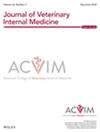Risk Factors for Pituitary Macrotumor in Dogs With Hypercortisolism
Abstract
Background
Diagnosing pituitary macrotumor in dogs with hypercortisolism requires advanced imaging, which is not feasible for every case. Identifying risk factors that can guide the decision to pursue imaging would be valuable.
Objective
Determine clinical and physical examination findings that are associated with an increased likelihood of pituitary macrotumors in dogs with hypercortisolism.
Animals
A total of 130 dogs diagnosed with hypercortisolism.
Methods
Retrospective study to analyze medical records for data on age, sex, breed, clinical signs, physical findings, endocrine test results, imaging results, diagnosis, and treatment. Logistic regression was used to identify risk factors for pituitary macrotumor, defined by a pituitary height/brain area ratio ≥ 0.4.
Results
Risk factors for pituitary macrotumor included diagnosis of hypercortisolism at ≤ 10.9 years of age (odds ratio [OR], 0.718; p < 0.05), French Bulldog breed (OR, 21.0; p < 0.01), and presence of neurologic signs (OR, 10.9; p < 0.001).
Conclusion and Clinical Importance
Advanced pituitary imaging should be recommended in dogs with hypercortisolism ≤ 10.9 years of age, French Bulldogs, and those presenting with neurological signs because these factors significantly increase the likelihood of pituitary macrotumor in dogs with hypercortisolism.


 求助内容:
求助内容: 应助结果提醒方式:
应助结果提醒方式:


